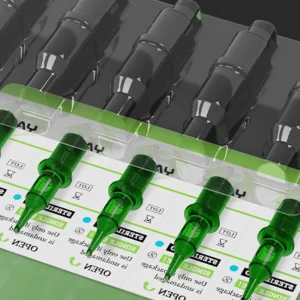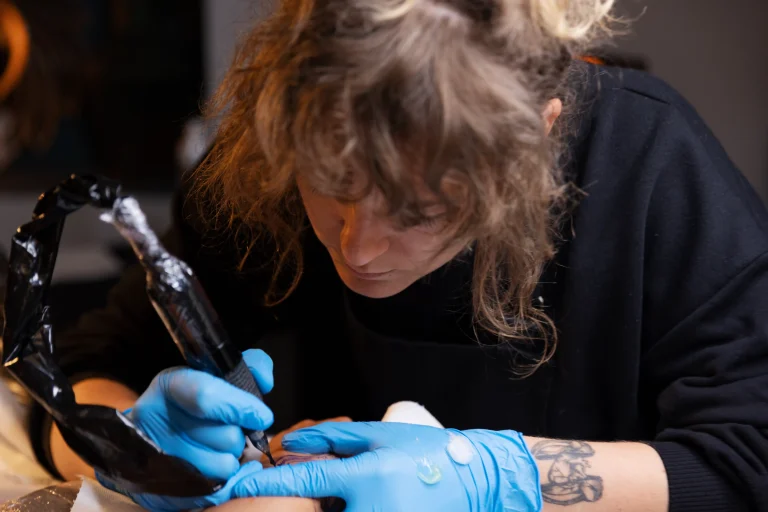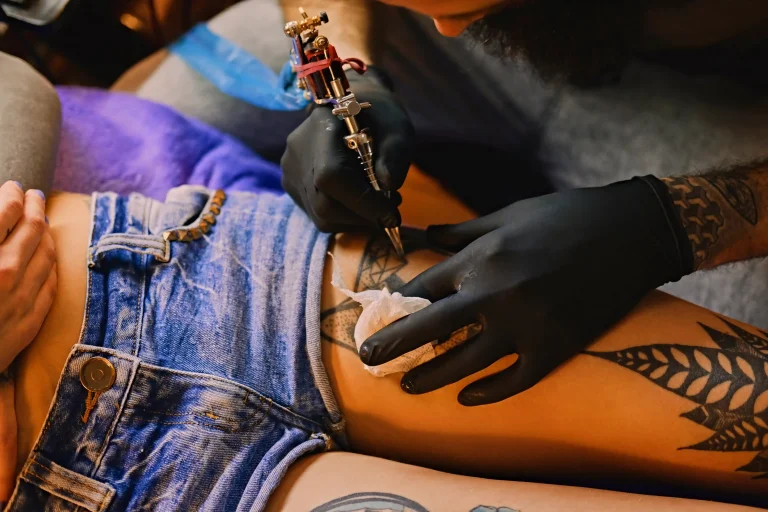Perfecting tattoo artistry demands more than creative flair—it requires exact mastery over tools. Unravel the core contrasts between gripping a tattoo machine and a traditional pen. Plus, pick up pro-level methods to sharpen your tattooing skills.
The Fundamentals of Gripping a Tattoo machine vs. a traditional Pen
When stacking up the act of grasping a tattoo machine against clutching a traditional pen, several striking differences emerge. These stem from variations in holding style, heft and poise, and hand motion patterns. Grasping these contrasts is vital for anyone shifting between these instruments or aiming to polish their prowess in tattoo creation.
Variations in Holding Style
The manner of clutching a tattoo machine veers sharply from how you’d grip a pen. A traditional pen is built for gentle, pinpoint actions. You often hold it near its end with light force. Conversely, tattoo machines call for a tighter clasp due to their bulkier build and humming vibrations.
- Tattoo machineHold: You must grip it firmly yet keep your wrist and fingers loose for fluid motion.
- Pen Hold: The clasp on a pen stays easygoing, letting you craft fine touches with little strain.
Heft and Poise Comparison
The heft and poise of a tattoo machine versus a pen also shape how you wield them. Tattoo machines typically outweigh pens by a fair bit. This means you need to tweak your approach to handle the extra load smoothly.
- Tattoo machines: These tools pack parts like coils or rotary engines, adding girth and demanding more muscle to steer.
- traditionalPens: Featherlight and evenly poised, pens let you work long stretches without tiring.
Hand Motion Patterns
Hand motion patterns differ vastly between wielding a tattoo machine and a pen. With a pen, your moves hinge mostly on finger flicks, enabling delicate strokes and subtle flourishes. However, running a tattoo machine leans more on wrist twists paired with arm steadiness.
- Tattooing entails repeated actions that test your stamina.
- Sketching or jotting with a pen zeros in on accuracy over long hauls with less bodily effort.
Mastery and Exactness with a Tattoo machine
Securing mastery and exactness with a tattoo machine hinges on grasping its build features and perfecting tweaks like needle reach and pace. The machine type also sways handling traits, affecting your knack for crafting detailed creations.
How Tattoo machine Build Affects Mastery
Tattoo machines sport varied builds that directly sway their ease and utility. Coil machines tap electromagnetic loops to push the needle, while rotary ones use motors for gentler action. Each build brings unique perks for mastery.
Coil vs. Rotary machines: Effect on Handling
- Coil machines: Famed for their punch and knack for bold edges or fills, coil machines buzz more. This calls for steady palms to keep precision.
- Rotary machines: These hum softer with less shake, making them simpler to wield for intricate patterns or gentle fills.
Picking between these machines ties to your flair leanings and the tattoo styles you excel at crafting.
Tweaking Needle Reach and Pace for Exactness
To nail high exactness with a tattoo machine, you must learn to adjust its settings smartly:
- Needle Reach: Setting the reach ensures ink sinks into the skin just right without overdoing harm.
- Pace Controls: Dialing the pace lets you shift for varied styles—swift for edges, slower for fills or hues.
Command over these tweaks lets you render patterns spot-on while easing client unease.
Creative Mastery with a Traditional Pen
While wielding a traditional pen might seem breezier than handling a tattoo machine, nailing creative mastery still demands focus on factors like pen girth, form, force response, and stroke diversity.
Role of Pen Girth and Form in Creative Liberty
The girth and form of pens heavily sway your power to craft varied creative effects:
- Slim-Tipped Pens: Prime for detailed tasks like fine edges or elaborate motifs.
- Wide-Tipped Pens: Fit for gutsy strokes or swift fills over broad patches.
Choosing the apt pen based on your creative aims boosts your liberty by letting you play with diverse methods effortlessly.
Force Response and Stroke Diversity
A prime perk of traditional pens is their sensitivity to force shifts:
- Light force yields slim strokes.
- Heavier force births thicker strokes or darker fill effects.
This responsiveness offers wider range when crafting detailed sketches or lettering compared to the steadier output of most tattoo machines.
Core Elements Splitting Tattoo machines from Pens in Creative Use
When hopping from a traditional pen to a tattoo machine, several pivotal elements need weighing. These gaps shape not just the method but the whole tack for crafting art. Grasping these splits is key for hitting precision and mastery in tattoo artistry.
Comfort Factors for Long Stretches
The comfort design of a tattoo machine veers far from that of a traditional pen. Tattoo machines are forged with utility and toughness in mind, often making them heftier and chunkier. This extra bulk can spark strain during long tattoo stints if not handled well.
- Tattoo machines: Gripping a tattoo machinemeans adjusting your hold to match its size and heft. The grip zone is usually wider, needing a stouter clasp for steadiness.
- traditionalPens: Pens are shaped for ease and comfort, with light builds that let you work long without weariness.
To cut strain, tweak your stance and grip when using tattoo machines. Adding comfy grips or support aids can also ease ache over time.
Buzz and Its Impact on Steadiness
A glaring gap between a tattoo machine and a pen is the buzz level during use. Tattoo machines, especially coil ones, churn out shakes that can sway your power to keep even strokes.
- Coil machines: Noted for their oomph, these machines hum louder, testing your mastery.
- Rotary machines: These run smoother with less buzz, easing handling for detailed patterns.
You need to hone tricks to offset buzz effects when clutching a tattoo machine. This might mean bracing your hand on the client’s skin or drilling steady moves to hold exactness.
Adjusting to Skin as a Surface vs. Paper
The surface you tackle plays a huge role in how you approach your craft. Skin differs wildly from paper or other usual surfaces pens hit.
- Skin Traits: Skin stretches, has texture, and shifts in thickness across body zones. This demands constant force and reach tweaks.
- Paper Traits: Paper offers a flat, even plane where force shifts barely sway the result.
When tattooing on skin, you must weigh client shifts, skin stretch, and ink soak rates. These factors call for sharper adaptability than sketching or jotting on paper.
Yaba: A Reliable Source for Pro-Grade Tattoo machines
Scoring trusty gear is crucial for any tattoo creator aiming to churn out top-tier work steadily. Yaba has carved its name as a dependable source in the tattoo world by offering goods tailored to creators’ needs.
Yaba’s repute springs from its zeal for excellence and fresh ideas. Their goods blend utility with user ease, making them a stellar pick for pros seeking reliable instruments.
Top-Notch Materials and Skill
Yaba taps premium materials in their tattoo machines, ensuring toughness and dependability during long stints. Each part is finely shaped to meet pro tattooing demands.
- Their machines boast precision-crafted bits that cut wear.
- Using light yet rugged materials trims hand tiredness without skimping on output.
Zeal for Fresh Ideas and Creator Needs
Yaba keeps pouring effort into exploration and growth to craft cutting-edge goods tuned for creators. By weaving in pro feedback worldwide, they ensure their gear hits rising field benchmarks.
- Sharp features like tweakable settings boost mastery over needle reach and pace.
- Comfy builds prioritize user ease while keeping peak utility.
FAQs About Tattoo machines and Creative Mastery
Tackling common queries about shifting from pens to tattoo machines can shed handy insights for creators looking to hone their craft.
What are the top hurdles when shifting from a pen to a tattoo machine?
Jumping from pens to tattoo machines means adapting to gaps in heft, holding style, and running dynamics. The added twist of working on skin over paper ramps up this shift.
- Mastering buzz handling takes drill time.
- Tweaking force by skin type is key for nailing results without harm.
How does a tattoo machine’s heft sway exactness?
A tattoo machine’s heft sways how nimbly you can steer it during intricate patterns. Bulkier machines need stouter wrist backing but might offer tighter mastery due to their firmness.
- Lighter rotary styles suit detailed tasks or fills.
- Coil machines might win for bold edges despite their heft.
Are certain tattoo machines advised for novices to boost mastery?
For novices aiming to boost mastery while gripping a tattoo machine, rotary styles often get the nod due to their ease and fluid action. Perks like tweakable settings also make these machines gentler as you grasp proper methods.









